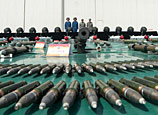
WASHINGTON, April 25 (Xinhua) -- U.S. researchers have fabricated arrays of piezotronic transistors capable of converting mechanical motion directly into electronic controlling signals, a step that could help give robots a human sense of touch.
The arrays made from bundles of vertical zinc oxide nanowires include more than 8,000 functioning piezotronic transistors, each of which can independently produce an electronic controlling signal when placed under mechanical strain.
"These touch-sensitive transistors -- dubbed 'taxels' -- could provide significant improvements in resolution, sensitivity and active/adaptive operations compared to existing techniques for tactile sensing," said U.S. Georgia Institute of Technology researchers in a statement. "Their sensitivity is comparable to that of a human fingertip."
The research was made available on Thursday in the journal Science online, and will be published later in a print version of the journal.
"Any mechanical motion, such as the movement of arms or the fingers of a robot, could be translated to control signals," explained Zhong Lin Wang, a Regents' professor at the Georgia Institute of Technology. "This could make artificial skin smarter and more like the human skin. It would allow the skin to feel activity on the surface."
In their laboratory, Wang and his colleagues fabricated arrays of 92 by 92 transistors. The array density is 234 pixels per inch, the resolution is better than 100 microns, and the sensors are capable of detecting pressure changes as low as 10 kilopascals -- resolution comparable to that of the human skin, said Wang.
The arrays are transparent, allowing them to be used on touch- pads or other devices for fingerprinting. They are also flexible and foldable, expanding the range of potential uses.
Because the arrays would be used in real-world applications, the researchers evaluated their durability. The devices still operated after 24 hours immersed in both saline and distilled water.
"This is a fundamentally new technology that allows us to control electronic devices directly using mechanical agitation," Wang said. "This could be used in a broad range of areas, including robotics, micro-electromechanical systems, human- computer interfaces and other areas that involve mechanical deformation."
















 Heavy rain affects traffic in S China
Heavy rain affects traffic in S China


![]()
